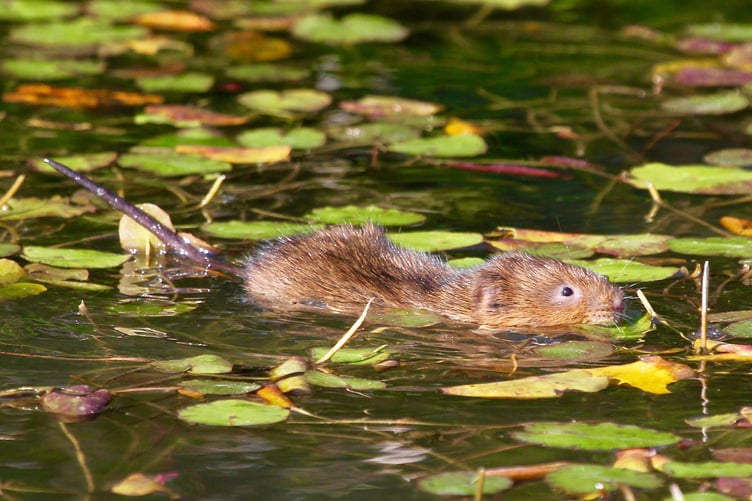Populations of these rare mammals have now been reintroduced from the South Downs to the Thames.
Led by the National Trust and Environment Agency, the conservation project brings together communities, landowners, and wildlife groups to protect and restore their habitats.
Water voles are a key species, vital for river ecosystems. Their numbers, however, have plummeted in recent years.
Britain's fastest declining mammal, the water vole, is being returned to the River Wey catchment in Surrey, Sussex and Hampshire, having previously been declared locally extinct.
This week, 150 water voles have been released at six carefully chosen sites on the upper reaches of the Wey, thanks to a partnership of local people, landowners and organisations, led by the National Trust, the Environment Agency, the River Wey Trust and the South East Rivers Trust.
It's the first in a programme of reintroductions over the next two years which will aim to create a sustainable population of water voles, that can breed and flourish, repopulating 1,000 sq km (386 sq miles) of the River Wey catchment area.
David Elliott, National Trust lead ranger for the South Downs West said: “These micro ecosystem engineers and delights of the river have all but disappeared on our watch. I knew the last of them here, more than 20 years ago. Now we are standing on the doorstep of their return, it’s an exciting moment.
“What’s unique about the project is the collaborative effort of so many people, coming together to enable the return of a species.
“From people with a tiny stretch of the river at the bottom of their garden, to major landowners and conservation organisations, all taking positive action.
“We live in times when there is huge dismay and often a feeling of powerlessness over the state of our rivers. This project demonstrates how citizens, organisations and communities working together can make change happen across a whole landscape.
“We can do much more for nature as a collective, rather than on our own.”
The work has been funded by the National Trust, the Environment Agency’s Water Environment Improvement Fund and the Black Down and Hindhead Supporters of the National Trust. The breeding programme is by Derek Gow Consultancy.
Partners across the catchment include the River Wey Trust, South East Rivers Trust, and multiple organisations, private landowners and dedicated volunteers.
The project covers 1,000 square kilometres of river catchment in Surrey, West Sussex and Hampshire – equivalent to 1 percent of England, or 2.5 times the size of the Isle of Wight.
Water voles play an important role in the biodiversity of riverside ecosystems. They are a source of food for at-risk predators like barn owls and otters.
Where they graze on grasses and rushes, they help reshape habitats and create space for rare plants to grow.
Yet during the 20th century, the population of the water vole in England declined by 93 percent and has been in further rapid decline since 2000.
Water voles from part of many people’s childhood memories thanks to the character Ratty – not a rat, but a water vole - in the classic children’s story The Wind in the Willows.
Once regularly spotted at the river bank, they became Britain’s fastest declining land mammal. The distinctive ‘plop’, as they enter the water, was a familiar sound for past generations.
One of the key reasons for this decline is predation by North American mink, which escaped from fur farms in the 20th century. Population numbers of water voles, and numerous other species of wildlife such as kingfishers and sand martins, have declined dramatically.
Now multiple partners and landowners across the River Wey catchment, led by the National Trust and Environment Agency are standing together to reverse this decline.
It follows two years of coordinated activity by river volunteers and monitors along the 87 mile waterway to prepare the way for them to thrive. Thanks to these collective efforts they are now ready for the return of the water vole to the River Wey.
Paul Davy, Environment Agency catchment coordinator for the River Wey, said: “We were keen to support this vital project and help re-establish the water vole, a much-loved native species and ecosystem engineer that has been absent from the Wey catchment for many years.
“This project has been a fantastic example of a catchment-based approach and effective partnership working. In addition to providing funding, the Environment Agency has helped the National Trust establish the network by drawing on our local knowledge and broad network of contacts within the catchment.”
Local volunteer Bryony Chapman, a member of the Black Down and Hindhead Supporters of the National Trust, has played a key role in the project.
She said: “Seeing nature return to sites near me is why I joined – to help support projects like this that might not happen otherwise. The National Trust rangers’ passion and enthusiasm for getting people involved in restoring nature is remarkable.
“I’m so pleased to be part of it. Water voles aren’t just lovely animals, they’re important to the whole ecosystem. With our rivers under such pressure, to be able to do something to help us to get back to a naturally functioning eco system is very rare and meaningful.”

.jpeg?width=209&height=140&crop=209:145,smart&quality=75)



Comments
This article has no comments yet. Be the first to leave a comment.